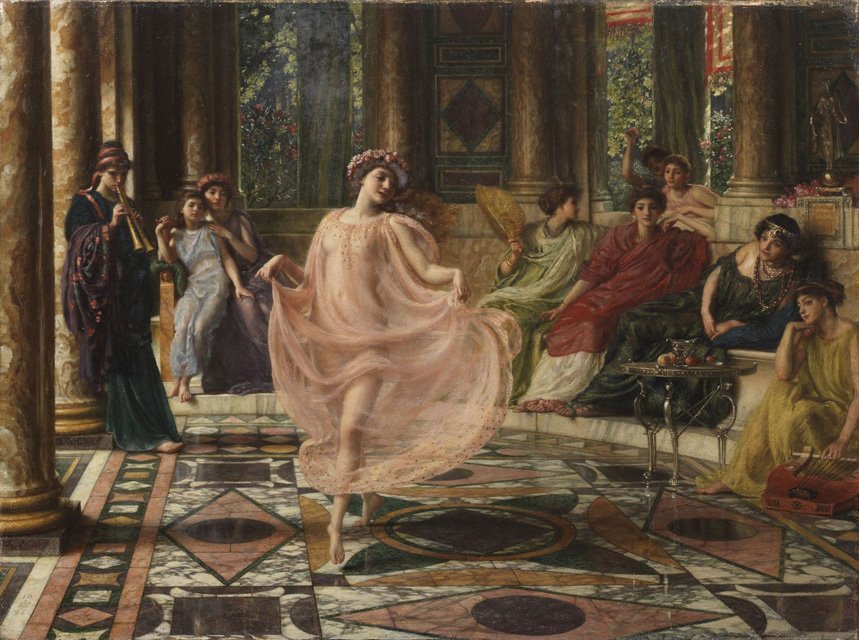Edward Poynter’s classical stories: 2 from 1880

By 1880, Sir Edward Poynter (1836–1919) was well-established as one of the leading artists of the day. Although he had painted some spectacular panoramas and some scenes from popular classical narratives, many of his paintings were more typical of the Aesthetic movement, lacking the intricate narratives of Frederic, Lord Leighton’s earlier works. Poynter was also taking leading roles in art education, and was by this time principal of the predecessor to the Royal College of Art in London.
Edward Poynter (1836–1919), A Visit to Aesculapius (1880), oil on canvas, 151.1 x 228.6 cm, The Tate Gallery (Presented by the Trustees of the Chantrey Bequest 1880), London. © The Tate Gallery and Photographic Rights © Tate (2016), CC-BY-NC-ND 3.0 (Unported), http://www.tate.org.uk/art/artworks/poynter-a-visit-to-aesculapius-n01586
A Visit to Aesculapius (1880) is an unusual motif. Although this image makes it appear to be a nocturne, this is probably darkening from aged varnish and dirt: contemporary prints (below) suggest it’s actually set in normally-lit daytime. Aesculapius, the ancient Greek god of medicine and the healing arts, sits at the left, contemplating the left foot of Venus with a thorn in it. She’s attended by doves, with the three Graces as her handmaidens.
Edward Poynter (1836–1919), A Visit to Aesculapius (after 1880), lithograph, other details not known, Wellcome Library, London. Courtesy of Wellcome Images images@wellcome.ac.uk http://wellcomeimages.org, via Wikimedia Commons.
Poynter arrays the Graces in classical manner, with one turning her back to the viewer, and reaching her right arm out to the figure of Hygieia, daughter of Aesculapius and the goddess of health and sanitation, who is drawing water from the fountain at the right. Shown at the lower edge of the painting is the staff of Aesculapius, around which a snake is entwined. That isn’t to be confused with the caduceus of Hermes (Trismegistus), which has two snakes intertwined.
Edward Poynter (1836–1919), Psyche in the Temple of Love (1882), oil on canvas, 66.3 x 50.7 cm, Walker Art Gallery, Liverpool, England. Wikimedia Commons.
Psyche in the Temple of Love (1882) returns to the theme of the contemplative woman, here in the context of a simple classical story. Cupid has fallen in love with Psyche, and takes her to the Temple of Love, where he visits her each night, but never in daylight. Here Psyche is whiling away the daytime, holding a sprig out to attract a butterfly, her attribute. However, Psyche’s enemy Venus is not far away, as implied by the doves in the temple behind her.
Edward Poynter (1836–1919), Diadumenè (1883), oil on canvas, 50.8 × 50.8 cm, Royal Albert Memorial Museum, Exeter, England. Wikimedia Commons.
Diadumenè (1883) is one of several paintings that Poynter made of the Esquiline Venus statue in Rome, which had only been discovered in 1874. He first saw the statue in about 1881, here ‘restoring’ its form into the figure of a beautiful young woman who is binding her hair with a strip of cloth in preparation for her bath. The title is a reference to Polyclitus’ Diadumenos, meaning ‘diadem bearer’, one of his two famous figural types, the other being Doryphoros, or ‘spear bearer’.
Light in narrative but a classical depiction of the female nude, this painting was exhibited at the Royal Academy in 1884. It resulted in correspondence in The Times newspaper which condemned “the indecent pictures that disgrace our exhibitions”, to which Poynter responded with a defence of such classical works. The figure’s nudity may have been enhanced by the presence of her clothing next to her, just as in Thomas Eakins’s William Rush Carving His Allegorical Figure of the Schuylkill River (1876-77). Ten years later, Poynter painted another version in which his Venus is partially clad, although her right breast still shows proud.
Edward Poynter (1836–1919), Outward Bound (1886), oil on canvas, 49.5 x 49.5 cm, The Tate Gallery (Bequeathed by Henry Evans 1904), London. © The Tate Gallery and Photographic Rights © Tate (2016), CC-BY-NC-ND 3.0 (Unported), http://www.tate.org.uk/art/artworks/poynter-outward-bound-n01948
Outward Bound (1886) shows two young boys playing in a small rock cave at the coast. They have a bamboo fishing rod with them, and have made a small boat, which appears to be floating out through the rock arch at the left towards the open sea. Although the phrase outward bound is now more usually associated with the movement started in around 1941 by Kurt Hahn, and Baden-Powell’s scouting movement wasn’t founded until 1910, there were contemporary advocates who promoted getting the poor out of cities to a healthier life in the country and at the coast.
Edward Poynter (1836–1919), Corner of the Marketplace (1887), oil on canvas, 53 x 53 cm, Private collection. Wikimedia Commons.
Corner of the Marketplace (1887) might have been painted by Poynter’s close contemporary Sir Lawrence Alma-Tadema, but for its joyous celebration of motherhood. Apparently it shows a maker of wreaths and floral displays at work, while the baby plays with a flower. However, the mother sat on a marble bench has a more pensive and wistful stare.
Edward Poynter (1836–1919), The Corner of the Villa (1889), oil on canvas, 62.5 x 62.5 cm, Private collection. Wikimedia Commons.
The Corner of the Villa (1889) may have been painted as a pendant to the previous work. Its ornate classical setting is almost overpowering in fine detail, threatening to outdo both Alma-Tadema and Gérôme. The family here is more patrician, and feeding pigeons from a bowl of seed. One of the birds is bathing and splashing in the drinking fountain at the left, and ripe apples are scattered on the marble floor.
Edward Poynter (1836–1919), The Visit of the Queen of Sheba to King Solomon (1890), oil on canvas, 234.5 x 350.5 cm, Art Gallery of New South Wales, Sydney, Australia. Wikimedia Commons.
The Visit of the Queen of Sheba to King Solomon (1890) is another of Poynter’s spectacles that might have been worthy of Gérôme. Inspired by the growing collections of antiquities from Egypt and the Middle East that had been gathering in the British Museum and elsewhere, it presents a simple orientalist narrative of the Queen of Sheba visiting King Solomon. Poynter again fills the painting with extraordinary detail, which spills over into its heavy, ornate frame. Orientalism was becoming the new classicism.
Edward Poynter (1836–1919), In a Garden (1891), further details not known. Wikimedia Commons.
In a Garden (1891) treats a sub-tropical garden to a similar level of detail, as a small figure sits reading in the shade of a large fan.
In 1894, Poynter became Director of London’s National Gallery, and remains the last practising artist to have run this major collection. During his period as Director, which lasted a decade, he oversaw the opening of the Tate Gallery.
Edward Poynter (1836–1919), The Ionian Dance: Motus doceri gaudet Ionicos, Matura virgo et fingitur artubus (1895), oil on canvas, 38.5 x 51 cm, location not known. Wikimedia Commons.
The Ionian Dance: Motus doceri gaudet Ionicos, Matura virgo et fingitur artubus (1895) quotes the ‘Roman’ Odes of Horace, and describes the ‘corruption’ of a young woman who learns the ‘lascivious’ movements of this particular dance. The Latin text may be translated as it pleases the mature virgin to be taught the movements of the Ionian Dance, and shapes her limbs. However, artubus may be a double entendre, as it can also refer to the sexual organs.
Poynter’s painting shows a shapely young woman, wearing nothing but a diaphanous dress, dancing vigorously in front of an audience of eight other women, who seem critically engaged in her performance. This appears decidedly Aesthetic, as well as more than a little risqué.
In 1896, Poynter was elected President of the Royal Academy at a time of difficulty: its long-standing President, Frederic, Lord Leighton, had died unexpectedly in January, and his successor, John Everett Millais, died in August. Poynter was knighted in 1896, and made a Baronet in 1902.
Edward Poynter (1836–1919), Helena and Hermia (1901), oil on canvas, 125.7 x 100.4 cm, Art Gallery of South Australia, Adelaide, South Australia. Wikimedia Commons.
Helena and Hermia (1901) shows two of the young lovers from William Shakespeare’s play A Midsummer Night’s Dream. Helena is an aristocrat from the court of Theseus, who was betrothed to Demetrius, to whom she remains devoted. Hermia is an Athenian who is caught in a romantic accident, in that she loves Lysander, but Demetrius loves her. Hermia is named after the Greek god of exchange and dreams, one of the central themes of the play.
Although caught in complex relationships, Helena and Hermia are good friends, and it’s their friendship that Poynter depicts, a popular theme for paintings in the nineteenth century. There is perhaps a little more symbolism buried in this work, though: a ball of red thread lies partly unwound on the ground at the lower right, possibly representing difficulties in the course of love.
Edward Poynter (1836–1919), Cave of the Storm Nymphs (1903), oil on canvas, 145.9 × 110.4 cm, Private collection. Wikimedia Commons.
At first sight, Cave of the Storm Nymphs (1903) might appear to be another excuse for three superb female nudes, but there is more complex narrative behind this scene. Its literary reference may be to the Naiads of Homer’s Odyssey, book 13, who live in a sea cave, updated to encompass more contemporary references to Wreckers, who lured ships onto the rocks in order to steal their precious cargos, sirens without the socially unacceptable habit of cannibalism.
Here the three Storm Nymphs are seen amid their rich takings, the more distant of them perched on a rock and holding a shell-based lyre, and a wrecked galleon breaking up in the huge sea beyond. The painting is rich in the beauty of the nymphs, the savage waves, and the evoked sounds and sensations associated with each.
Edward Poynter (1836–1919), Asterié (1904), oil on canvas, 140 x 110 cm, Te Papa Tongarewa (Gift of Sir Alexander Roberts, 1960), Wellington, New Zealand (1960-0001-1). By courtesy of Te Papa.
Asterié (1904) returns to a thoroughly classical narrative, taken from Horace’s Odes, books 3 and 7. Asterié is a Greek wife, left behind in Athens while her husband is away in the service of the state. She is being stalked by the god Zeus, who lurks in human form down in the street below. She looks down at him, pondering what to do: whether to succumb to his desires, or to retain her virtue? Clutching a carnation (also adorning her hair), a symbol of marital fidelity, she looks to be standing by her absent husband, but the question is left open for the viewer to speculate.
This painting was first exhibited at the Royal Academy in 1904, but remaining unsold, was sent to New Zealand for the 1906 New Zealand International Exhibition in Christchurch, where it was finally sold.
Edward Poynter (1836–1919), Lesbia and Her Sparrow (1907), oil on canvas, 49 × 37 cm, Private collection. Wikimedia Commons.
Lesbia and Her Sparrow (1907) might these days be easily misread from its title. In fact, Lesbia was the literary pseudonym used by Gaius Valerius Catullus, the Roman poet, for his lover, who’s traditionally thought to have been another man’s wife. She came to dominate nearly a quarter of Catullus’ surviving poems, and appears in several contemporary paintings: Lawrence Alma-Tadema painted her at least twice, and several of those paintings show her with her devoted pet sparrow. For Poynter, it appears to be another Aesthetic work invoking the sparrow’s song, and the taste of grapes.
Poynter appears to have largely retired by the start of the First World War, and died shortly after its end. He was so greatly respected that he was buried in St Paul’s Cathedral, London, just as Sir Joshua Reynolds had been. He had been a prolific, highly successful, and influential artist. His work includes classical narratives as sophisticated as Frederic, Lord Leighton’s, spectacles as good as the best of Gérôme, and some of the best paintings to emerge from the Aesthetic movement. Yet he has no catalogue raisonné, no monograph on his paintings, nor have his works been exhibited together since 1920, apart from a small exhibition in Brighton College’s Burstow Gallery in 1995.
References
Wikipedia.
Ten Lectures on Art (1880), by Sir Edward Poynter, at archive.org: an Aesthetic manifesto.


